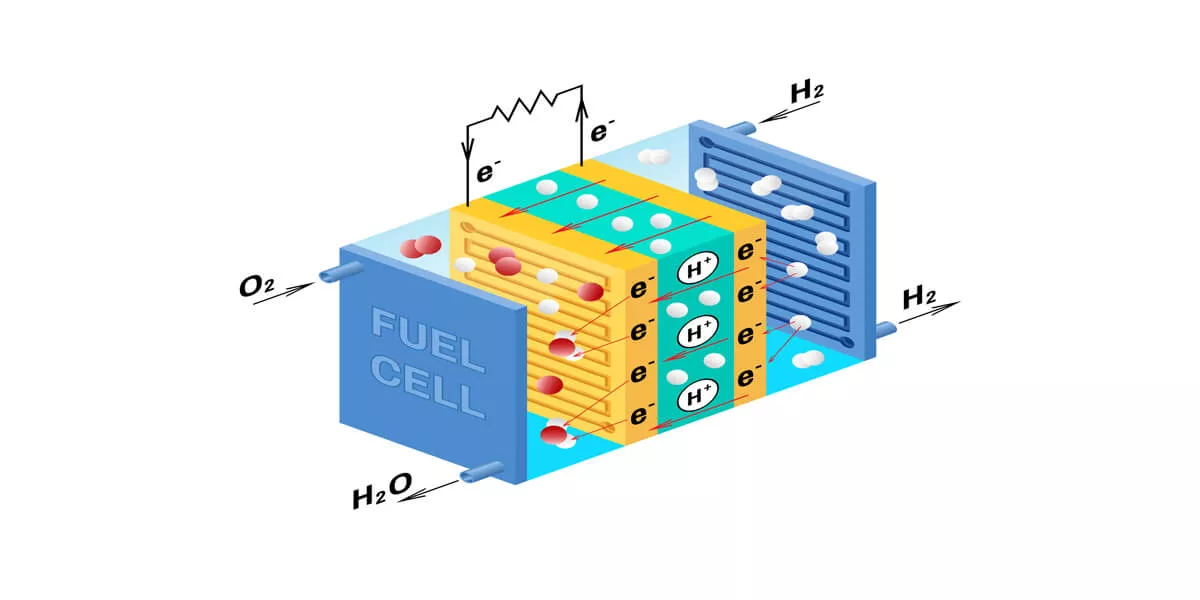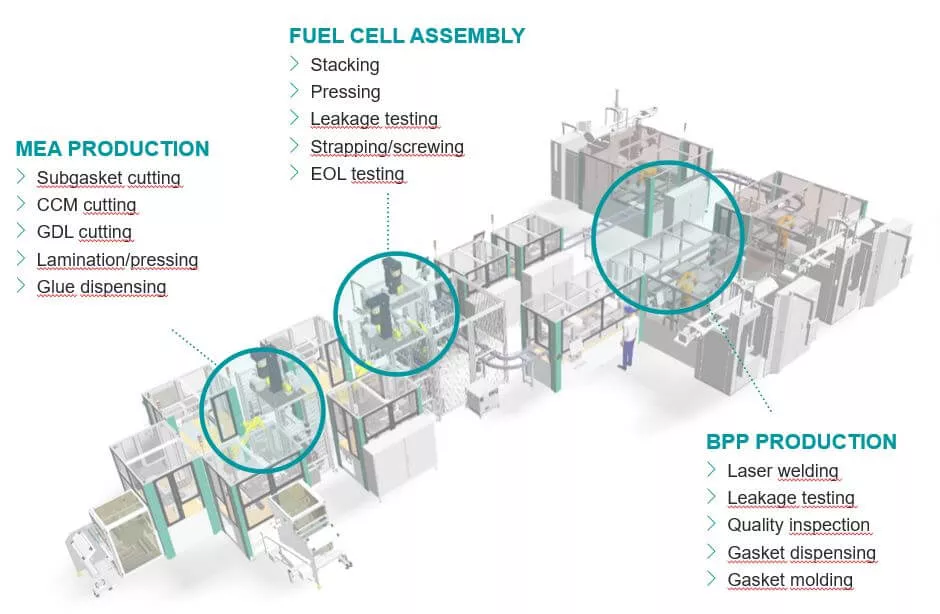
Functionality and fields of application of fuel cells
A fuel cell is a galvanic cell in which a reaction occurs between a fuel and an oxidant. Most commonly, hydrogen is used as the fuel and oxygen as the oxidant. The reaction produces three products: thermal energy, electrical energy and water. The principle of the fuel cell was already discovered in the first half of the 19th century, and today fuel cells are used in various fields of application. Particularly with a view to the energy transition, fuel cells are considered to be of great relevance - among other things in the fields of industry and transport.
Short review: The history of the fuel cell
The functional principle of the fuel cell was developed as early as 1838 by Christian Friedrich Schönbein. Within a very short time, the so-called "galvanic gas battery" was seen as an option for the energy supply of the future. At least as quickly, however, the fuel cell fell into oblivion again, as less complicated solutions for energy generation - such as the electric generator - enjoyed a larger following.
It took until the middle of the 20th century before the fuel cell fought its way back out of obscurity. At that time, it was primarily the aerospace and military industries that recognized the specific advantages of the fuel cell as an energy source: The compact design with maximum performance was just perfect for use in situations where space savings and the lowest possible weight were important. This is still one of the many advantages of the fuel cell today.
How does a fuel cell work?
The fuel cell operates on the basis of an electrochemical reaction. Unlike a battery, a fuel cell is therefore not an energy store, but rather an energy converter - the conversion of the chemical energy of the fuel takes place directly in the fuel cell. For this to succeed, a specific setup is required.

Structure of the fuel cell
The actual design of a fuel cell differs depending on the type and intended use. The polymer electrolyte membrane fuel cell, also known as PEM or PEMFC, has been particularly well researched and is widely used in the automotive industry. For this reason, this type of fuel cell will be examined in more detail below.
A fuel cell has two electrodes - one anode and one cathode. Between the two there is a polymer membrane as electrolyte. This membrane has two tasks: It is responsible for separating the two electrodes from each other and ensuring selective ion transport between them.
Function of the fuel cell
The fuel cell is first supplied with hydrogen as fuel and oxygen as oxidant. It is important to note that the hydrogen supply is located at the anode, while the oxygen supply is located at the cathode. The hydrogen molecules are split at the anode - into positively charged protons and negatively charged electrons. While the protons can pass through the membrane of the fuel cell unhindered and flow to the cathode, this path is blocked for the negatively charged electrons.
Put simply, the negatively charged electrons have to take a detour to get to the other side, to the cathode. In doing so, they flow over an electrical conductor and can release their electrical energy there. Electricity is generated. Once they reach the other side of the membrane, the electrons react with the oxygen to form water in the same way as the protons. During this part of the process, heat is also released as thermal energy.
Important: In the fuel cell, no combustion takes place, but rather a conversion of hydrogen and oxygen. This makes the fuel cell very low-maintenance and efficient. At the same time, the electrochemical reaction inside the fuel cell is completely emission-free - which makes it so extremely interesting for the energy transition.
What fields of application are there for the fuel cell?
The extent to which fuel cells are suitable for certain fields of application or use depends on various factors. Above all, performance and capacity are decisive. However, service life is also an important factor in ensuring that fuel cells can be used profitably.
Autonomous systems
Raumfahrt und Militär waren die ersten Branchen, die Brennstoffzellen vermehrt eingesetzt haben. Sie werden für die Energieversorgung autarker Systeme – beispielsweise für U-Boote oder Raumfahrzeuge – genutzt.
Portable applications
Die Idee, dass sämtliche mit einer wieder aufladbaren Batterie ausgestatteten mobilen Geräte für die Energieversorgung auch mit einer Brennstoffzelle ausgestattet werden könnten, ist nicht neu. Zahlreiche Unternehmen haben sich bereits an der Entwicklung kleiner Brennstoffzellen für Laptops, Digitalkameras und andere mobile Geräte versucht. Doch eine wirklich erfolgreiche Markteinführung konnte bis dato noch nicht realisiert werden. Die Ursache für bislang fehlgeschlagene Markteinführungen von Brennstoffzellen für mobile Anwendungen ist hauptsächlich in den vergleichbar hohen Kosten zu sehen.
Mobile applications
Brennstoffzellen kommen bei der Energieversorgung von Elektroautos, sogenannten FCEV (Fuel cell electric vehicle) bzw. Brennstoffzellenfahrzeugen zum Einsatz. Insbesondere bei Flurförderzeugen, die in Gebäuden betrieben werden, sind sie bereits relativ weit verbreitet. Hier ermöglichen sie gegenüber batteriebetriebenen Fahrzeugen einen deutlich effizienteren Einsatz, weil lange Ladezeiten vermieden werden. Auch im individuellen Straßenverkehr ist die Brennstoffzellen-Technologie angekommen – wobei ein breiter Einsatz angesichts fehlender infrastruktureller sowie technischer Voraussetzungen noch nicht umgesetzt wurde. In den Bereichen Nutzfahrzeuge, Schienenverkehr und Schifffahrt ist die Nutzung dagegen jetzt schon gefragt, da die Brennstoffzellenfahrzeuge ohne große Batterie ein deutlich geringeres Gewicht bei gleichzeitigem Reichweitenvorteil garantieren. Zudem kann eine ausreichende Versorgung des Güterverkehrs mit dem bereits vorhandene H2-Tankstellennetz entlang der Hauptachsen schon heute sichergestellt werden.
Stationary applications
Im Bereich der stationären Anwendungen kommen Brennstoffzellen vorwiegend als Brennstoffzellenheizungen zum Einsatz. Je nach Größe können Modelle für die Versorgung von Privathaushalten genauso wie für die Energieversorgung von Unternehmen verwendet werden. Der Fokus liegt dabei meist auf der Nutzung der Wärmeenergie, wobei hierfür meist auf sogenannte Hochtemperaturbrennstoffzellen zurückgegriffen wird. Die Nutzung der freigesetzten elektrischen Energie erfolgt oft im Sinne einer Notstromversorgung, um Netzausfälle abzusichern. Grundsätzlich können Brennstoffzellen aber auch dazu dienen, eine Stromversorgung, etwa in netzfernen Gebieten, sicherzustellen oder die dezentrale Stromversorgung in der Industrie abzudecken. In diesem Zusammenhang ist die Kombination mit einem Elektrolyseur besonders sinnvoll: So kann über Photovoltaik oder Windkraft erzeugte Energie in Wasserstoff umgewandelt werden, der dann zum Beispiel in Gasflaschen oder Metallhydridspeicher zwischengespeichert werden und bei Bedarf in der Brennstoffzelle in nutzbare elektrische Energie zurückgewandelt werden kann. Derartige Systeme sind als Fertiglösungen für Ein- oder Zweifamilienhäuser sowie im industriellen Maßstab bereits verfügbar. Der besondere Vorteil: Hier werden praktisch endlos verfügbare erneuerbare Energien direkt am Entstehungsort genutzt.
Conclusion: Fuel cells as an important factor in the energy transition
Fuel cells achieve high efficiency with a relatively simple principle and - depending on the origin of the fuel used - are capable of generating green energy. This is mainly due to the fact that energy generation with their help can be emission-free. In the future, the expansion of the technology can be expected to reduce the costs of fuel cells, which have been high up to now. Currently available fuel cell generations are generally still manufactured in small batches. Due to the high labor costs, production is very expensive. As the degree of automation increases and production numbers rise, manufacturing costs will fall dramatically, opening up a broader range of applications at the same time. The basic prerequisite for this step is the incorporation of design specifications suitable for automation. A fuel cell consists of several hundred cells, each of which in turn consists of a MEA (membrane electrode assembly), a BPP (bipolar plate) and a gasket. "Bottleneck" of the current production of fuel cells is besides the time-consuming conditioning also the pure stacking process of the cells. New approaches to stacking are needed to meet the growing demand in the future.
